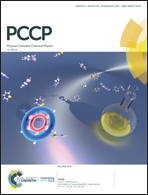The influence of Ho3+ doping on 13C DNP in the presence of BDPA†
Abstract
Polarization transfer from unpaired electron radicals to nuclear spins at low-temperature is achieved using microwave irradiation by a process broadly termed dynamic nuclear polarization (DNP). The resulting signal enhancement can easily exceed factors of 104 when paired with cryogenic cooling of the sample. Dissolution-DNP couples low temperature polarization methods with a rapid dissolution step, resulting in a highly polarized solution that can be used for metabolically sensitive magnetic resonance imaging (MRI). Hyperpolarized [1-13C]pyruvate is a powerful metabolic imaging agent for investigation of in vitro and in vivo cellular metabolism by means of NMR spectroscopy and MRI. Radicals (trityl OX063 and BDPA) with narrower EPR linewidths typically produce higher nuclear polarizations when carbon-13 is the target nucleus. Increased solid-state polarization is observed when narrow line radicals are doped with lanthanide ions such as Gd3+, Ho3+, Dy3+, and Tb3+. Earlier results have demonstrated an incongruence between DNP experiments with trityl and BDPA, where the optimal concentrations for polarization transfer are disparate despite similar electron spin resonance linewidths. Here, the effects of Ho-DOTA on the solid-state polarization of [1-13C]pyruvic acid were compared for 3.35 T (1.4 K) and 5 T (1.2 K) systems using BDPA as a radical. Multiple concentrations of BDPA were doped with variable concentrations of Ho-DOTA (0, 0.2, 0.5, 1, and 2 mM), and dissolved in 1 : 1 (v/v) of [1-13C] pyruvic acid/sulfolane mixture. Our results reveal that addition of small amounts of Ho-DOTA in the sample preparation increases the solid-state polarization for [1-13C] pyruvic acid, with the optimum Ho-DOTA concentration of 0.2 mM. Without Ho-DOTA doping, the optimum BDPA concentration found for 3.35 T (1.4 K) is 40 mM, and for 5 T (1.2 K) system it is about 60 mM. In both systems, inclusion of Ho-DOTA in the 13C DNP sample leads to a change in the breadth (ΔDNP) of the extrema between the P(+) and P(−) frequencies in microwave spectra. At no combination of BDPA and Ho3+ did polarizations reach those achievable with trityl. Simplified analysis of increased polarization as a function of decreased electron T1e used to explain results in trityl are insufficient to describe DNP with BDPA.



 Please wait while we load your content...
Please wait while we load your content...